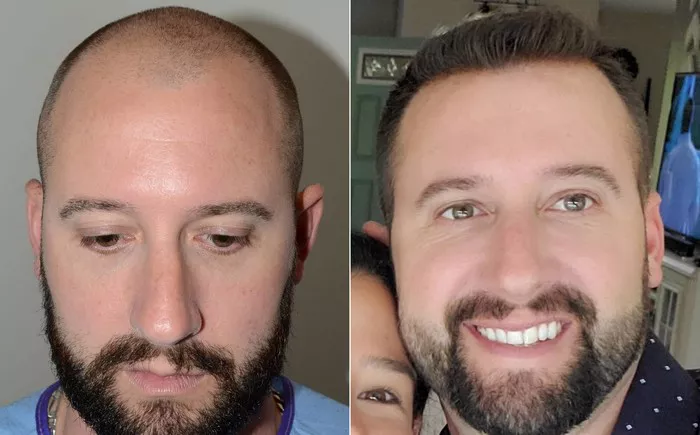Hair loss is a common concern for many individuals, impacting not only their physical appearance but also their self-esteem and confidence. In the pursuit of regaining a full head of hair, hair transplantation has emerged as a popular and effective solution. However, amidst the excitement of undergoing such a procedure, questions often arise regarding the growth and longevity of transplanted hair. In this comprehensive article, we aim to provide clarity on the question: “Will hair transplant hairs grow?” by debunking myths and exploring the realities associated with this transformative procedure.
Understanding Hair Transplantation: A Brief Overview
Before delving into the growth dynamics of transplanted hair, it is essential to grasp the fundamentals of hair transplantation. The procedure involves the relocation of healthy hair follicles from a donor site, typically the back or sides of the scalp, to areas experiencing hair loss or thinning, known as the recipient site. Hair transplantation techniques have evolved significantly over the years, with two primary methods dominating the field: Follicular Unit Transplantation (FUT) and Follicular Unit Extraction (FUE).
FUT involves the removal of a strip of skin containing hair follicles from the donor area, which is then dissected into individual follicular units for transplantation. On the other hand, FUE entails the extraction of individual follicular units directly from the donor site using a specialized punch tool. Both techniques offer effective means of restoring hair density and are performed under local anesthesia on an outpatient basis.
Dispelling the Myth: Will Transplanted Hairs Grow?
One of the most prevalent misconceptions surrounding hair transplantation is the uncertainty regarding the growth of transplanted hairs. Contrary to popular belief, transplanted hairs do indeed grow and thrive in their new location. The success of hair transplantation hinges on the principle of donor dominance, which posits that hair follicles extracted from areas resistant to the effects of Dihydrotestosterone (DHT), the hormone responsible for hair loss, will retain their inherent characteristics when transplanted to balding areas.
Upon transplantation, the relocated hair follicles undergo a process known as anagen effluvium, wherein they enter a resting phase before regrowth occurs. This temporary shedding of transplanted hairs, typically within the first few weeks to months post-surgery, is a natural part of the hair growth cycle and should not be cause for concern. Subsequently, new hair growth emerges from the transplanted follicles, gradually thickening and blending seamlessly with the surrounding hair, resulting in a natural-looking outcome.
Factors Influencing Hair Growth Post-Transplantation
While the growth of transplanted hairs is a predictable outcome of hair transplantation, several factors can influence the rate and quality of hair growth post-surgery. Understanding these factors is crucial for managing expectations and optimizing the results of the procedure:
1. Patient-specific Variables: Individual factors such as age, genetics, overall health, and lifestyle habits can impact the success of hair transplantation. Younger patients with good overall health and a stable pattern of hair loss tend to achieve optimal results compared to older individuals with advanced hair loss or underlying medical conditions.
2. Skill and Experience of the Surgeon: The expertise and proficiency of the surgeon performing the hair transplantation significantly influence the outcome of the procedure. Experienced surgeons with a keen understanding of facial aesthetics and hair restoration techniques can achieve superior results with minimal risk of complications.
3. Transplantation Technique: The choice of transplantation technique, whether FUT or FUE, can also influence the growth and survival of transplanted hairs. While both methods yield comparable outcomes, the specific needs and preferences of the patient, along with the extent of hair loss, may dictate the most suitable approach.
4. Post-operative Care: Proper post-operative care and adherence to the surgeon’s instructions are imperative for ensuring successful hair growth post-transplantation. This includes avoiding strenuous activities, protecting the scalp from direct sunlight, refraining from smoking or alcohol consumption, and following a prescribed medication regimen to promote healing and minimize the risk of complications.
5. Hair Growth Timeline: It is essential to recognize that the growth of transplanted hairs occurs gradually over several months following the procedure. While some patients may notice visible growth within three to four months post-surgery, full results typically become evident between 12 to 18 months, as the transplanted hairs undergo successive growth cycles and achieve optimal density and coverage.
Managing Expectations and Realistic Outcomes
As with any surgical procedure, managing expectations and understanding the limitations of hair transplantation are paramount for achieving realistic and satisfactory outcomes. While hair transplantation can effectively restore hair density and improve the aesthetic appearance of the scalp, it is essential to recognize that it is not a cure for baldness or a guarantee of lifelong hair retention.
Moreover, while the transplanted hairs are resistant to DHT and less susceptible to future hair loss, they are not entirely immune to the effects of aging or genetic predisposition. As such, some degree of ongoing hair maintenance may be necessary to preserve the results of the procedure and address any further hair loss that may occur over time.
Conclusion
In conclusion, the question “Will hair transplant hairs grow?” can be unequivocally answered in the affirmative. Hair transplantation offers a reliable and permanent solution for individuals seeking to restore their natural hairline and regain confidence in their appearance. By dispelling myths and understanding the realities associated with the procedure, patients can make informed decisions and embark on their journey towards achieving a fuller, more youthful head of hair.


